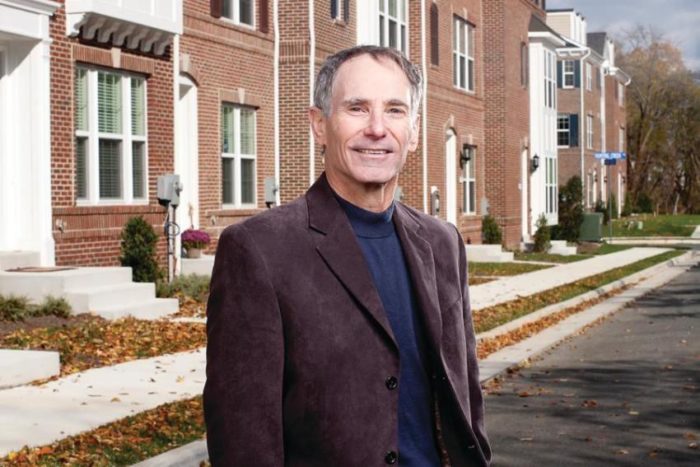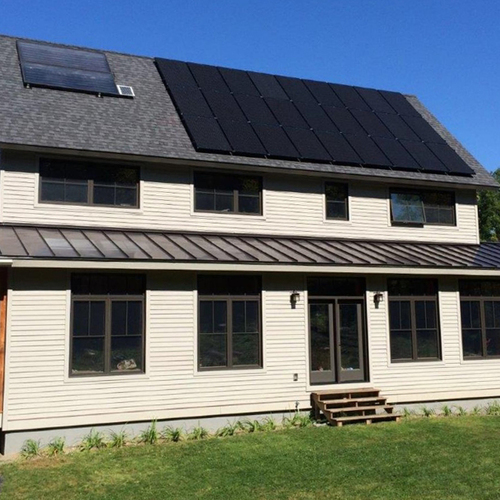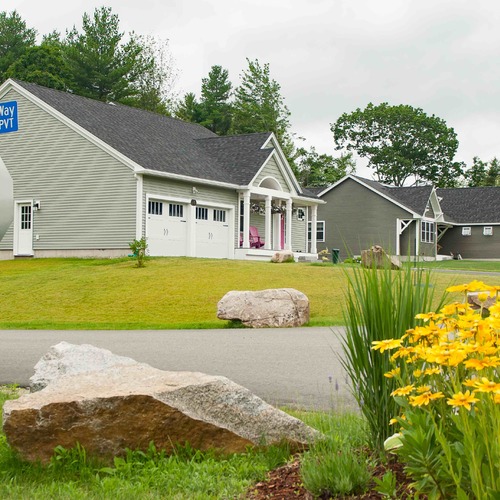Image Credit: Image #1: U.S. Department of Energy
Image Credit: Image #1: U.S. Department of Energy This house was built by New Town Builders of Denver, Colorado. New Town Builders won the Zero Energy Ready Home Grand Award in 2014 under the Production Builder category. The company is in the process of converting all of its product lines to zero-energy-ready construction.
Image Credit: Image #2: New Town Builders
Sam Rashkin is a man with a mission: a mission no less ambitious than to change the way American homebuilders conceive, construct, and promote their products.
As the father of the Energy Star Certified Homes Program, and now as chief architect of the building technologies office at the U.S. Department of Energy, his day-job description involves promoting super-energy-efficient construction. As a designer with businessman’s heart, he prefers to call it high performance construction.
Building Ferraris
If you resent increasingly stringent energy codes, which now address indoor air quality concerns and incorporate a whole-house, engineered-standards approach to construction, then Sam Rashkin would challenge you to move beyond mediocrity and embrace the trend toward higher building standards. He would convince you by showing you the numbers, gathered over two decades with the Builder’s Challenge and now with the Zero Energy Ready Home program.
Sam will guarantee that if you build high-performance homes, you will be more profitable.
“If you think only about first costs, and plan to compete with fire-sale homes, you have an old and now-defeated business model,” he told me. Then he fleshed it out with an example: “I’ve been working with builders for the last two decades or so, and I have built long-term relationships with a whole cadre of builders, in different markets — maybe 60 or more — and in my mind it’s like a secret club. These builders each put up about 20 homes a year, and what they experience is near zero callbacks and no marketing expenses, because they have a very loyal following. And they have higher profit margins because their customers know the value of their product.”
Sam was struck by the business angle of building high-performance homes. He realized that “high performance” could be an effective message to promote better building standards: in effect, setting a high bar as a standard, in the same way that successful manufacturers not only provide a commodity service, such as transportation, computing, or phone calls, but also establish an aura of exceptionality that defines the marketplace. Think Audi, Apple, and, well … Apple.
Branding is bragging
“When I buy a Lexus or a Prius, it does not perform or look like a Toyota Corolla,” says Sam. “High-performance homes, like Ferraris, define an architectural brand. To be successful in marketing high-performance homes, you cannot keep making the same-looking house, but better — it has to have an elite look that brands it as something more desirable. Yeah, it costs a little more, so make it distinctive so people know it’s something special.”
Sam gets excited as when he makes his pitch: “Work with me,” he says, urging builders to join him in the Zero Energy Ready Home program, “and do a few — just 15 to 20 of these high-performance homes — and you will see such a radical change in your profit margins. You’ll be convinced it’s the strategy for you.”
Zero Energy Ready Homes
The Zero Energy Ready Home program is a Department of Energy (DOE) initiative to encourage builders to construct now what we will all be building by 2020 — that is, homes that are so energy-efficient that a renewable energy system, such as a roof-mounted solar array, can offset all or most of the annual energy consumption.
Sam’s program at DOE goes beyond energy to incorporate just about every high-performance standard, such as indoor air quality, 300-year durability, and natural disaster resistance — rigorous requirements that the DOE says will ensure outstanding levels of water and energy savings, comfort, health, and durability. If you partner with the DOE, they will provide plenty of promotional material.
In fact, Sam suggests that builders get involved in any and all the builder programs, from Energy Star to LEED for Homes, as a means of marketing by association with established brands that represent high quality standards, along the lines of “Intel Inside.” Involvement in multiple programs also assures a well-rounded approach to construction that leads to better quality than any single-focus program can supply.
But keep in mind that while a Ferrari represents high performance, it also represents social status, high design, and economic success, in the same way that a Rolex wristwatch represents much more than a timekeeping instrument. So it pays to partner with an excellent architect who can provide the chic necessary to showcase high style, not just energy performance. People still want to embody their green moral values and long-term energy-saving goals in elegant wrappings.
Two books worth reading
Sam wrote a book about it, Retooling the U.S. Housing Industry, in which he examines the five critical components of our industry: land development, design, construction, performance, and sales. Published in 2010, it’s only slighted dated. Sam is a home building futurist, so most of us have not yet caught up to his old standards. It’s brief and practical. I do recommend it.
To help you sell your product, I also recommend Sam’s book for home buyers, How to Avoid the 10 Biggest Mistakes Buying a New Home. Not that you’ll learn something new as a builder, but this book, inspired by questions from friends and family, addresses the most common pitfalls in selecting and negotiating for a new home. It will certainly help you in conveying the benefits of your high-performance home over the competition.
Fernando Pagés Ruiz is a developer and author who speaks, writes, and consults on how to build high-quality, affordable, and energy-efficient homes. A builder with 30 years of experience, Pagés is the author of two books published by the Taunton Press: Building an Affordable House (2005) and Affordable Remodel (2007).
Weekly Newsletter
Get building science and energy efficiency advice, plus special offers, in your inbox.
















12 Comments
high performance homes
Fernando: Thank you. I also build high performance homes. Can you tell me if you or your builder friends have consistent success getting your homes to appraise?
Response to Terry Lee
Terry,
I agree that the current situation with green appraisals is probably less rosy than Sam Rashkin asserts.
GBA has published a great many articles on this topic. Here is a sampling:
One Broker’s Take on the Selling Power of Green
Marketing High-Performance Homes
When Green Poses an Appraisal Problem
Green Building Appraisal and Financing Issues
Getting a Grip on Green-Home Appraisals and Insurance
Green Home Appraisal Woes
A Step Toward Fairer Green Home Valuations
To Capture Green Value, We Need a Long Perspective
Seeing Red on a Green Property Appraisal — Part 1
Seeing Red on a Green Property Appraisal — Part 2
Seeing Red on a Green Property Appraisal — Part 3
Putting Value on Green Enhancements
Green Appraisals
"And they have higher profit margins because their customers know the value of their product.”
Incorrect....Most market places and industry does not understand the value due to a lack of understanding in appraisals, markets are gridlocked due to this. According to Fannie May, Freddie Mac, FHA, the appraisal has to have knowledge of the "specific geographical location and particular property type" so if you find an appraiser on the "Residential Valuation of Sustainable Building" list (see below) that is a start, they also have to know the "location". Unlikely, since most appraisers have no interest in taking and funding the extensive training if there is no market to profit and, the client demand is not understood (where is the data on this?). Not only that but, they have additional training in valuing solar, all of which takes complex present and future valuations financial models best performed by products like DOE BEOPT, PV value, etc, or other simulation modeling. The amount of time in the design phase and getting local infrastructures (banks, appraisers, agents, trades, clients) on board is huge and untouchable for most, time needs to be accounted for since I doubt most builders/DIYs are going to be able to run the models, understand it all, or afford to hire it out IF they can even find a qualified person, especially when it comes to IAQ which is more than selecting the proper ventilation rates. I'm baffled where Raskin is getting his info since these 2015 valuations tools are too new and under utilized.
If all that cannot be realized in tools like the “Residential Green and Energy Efficient Addendum” (AGREEA) which finally goes beyond LEED and Energy Star thank goodness, in the appraised value of the home, nobody (and that includes clients) understands the value of these Green products. In the meantime, DIYs that have the cash to perhaps burn will move the market in small increments, it won't be large until the proper valuations are understood for spec homes and commercial. Further, new requirements like finding a qualified rater that has the training in 2015 IECC, ERI vs HERS, required for a proper valuation.
I'm in the middle of this now taking the bull by the horn spending massive amounts of time with local and national banks and appraisers, agents, etc, fighting to get the proper valuations for Energy Efficient Mortgages for my clients. The most the appraisers are willing to do it put some notes in the appraisal which is not going to cut it. Put a green home in the wrong location where the valuations are not realized and there will be a loss, not profit. For those that do succeed there will be little competition for quite some time :)
https://www.appraisalinstitute.org/assets/1/7/AI_820_04-Residential_Green_and_Energy_Effecient_Addendum.pdf
http://www.myappraisalinstitute.org/findappraiser/green_sustainability_residential.aspx#note
IMO this is a code adoption issue.
Tract built energy efficient homes built in states that are slow to adopt current code will generally have difficulty appraising out. The degree of difficulty will depend on how energy efficient they are.
This isn't necessarily an issue with luxury homes because the additional construction costs associated with upgraded efficiency account for a smaller percentage of the overall cost to build.
Another issue is occupant behavior. Lender's can't control occupant behavior. It's a variable expense for the borrower so as a lender you don't want to put much weight in adding value for "energy efficiency".
My $.02
Solutions
It be a dream come true if they mandate 2015 IECC around me, that bankrupt about 98% of my competition...My local BSO knows that or they done it by now. I don't think more write ups like this is the solution, USDOE has plenty of and admits the amount of write-ups is confusing the situations....One could take the R&D design effort and multiple it by 1000s just to read it all. Whats is needed is less talk and more education of the entire infrastructure not just appraisers. More US tax dollars should be spent writing less that at the grass roots levels confuses the matters, most should be spent sending liaisons out to jurisdictions to put the infrastructure together instead of people like me having to do everyone's job for them, to gain massive amounts of knowledge to wear several hats, far beyond Architects, multidisciplinary engineers and accountants, more less builders and DIYs. I feel like a college professor in practice. I called my local state Appraisers office President recently, worthless, had not even taken the courses had no idea how to help or what I am talking about. My local "Economic Developers" have no idea what they are doing, nor does my BSO, they are the most entertaining and waste of tax dollars. Talked to a local credit union loan officer today about getting on board with me, he mentioned a client they recently approved doing some type of "German Design" I informed I also do as PHI now PHIUS, we both agreed the DIY was in negative equity they put more down to cover the unknowns. Ahhh, how times will change, I can only hope :)
Marketing the Low Energy Home
I'm building and selling low and zero energy homes in Denver, CO.
I haven't yet seen much market demand for low HERS scores.
There is one local realtor who believes there is a demand, and I will be listing a house with her soon just to see if she's right. She happens to be an energy rater also.
Yes, the whole HERS or ERI rating system is too complicated for most homebuyers to bother educating themselves on.
Realtors have not stepped up and educated themselves in order to explain it to customers. Only one in twenty realtors I've met can even explain the difference between a kilowatt and a kilowatt-hour.
A rating system in DOLLARS PER YEAR would be much simpler and might even make sense to homebuyers. Dollars per year is a more important metric because it gives smaller homes better scores, which HERS doesn't.
Some good news in Denver -- there are several experienced energy rating firms that can generate HERS scores for builders at a reasonable price. This is good, because the best way to meet the IECC 2015 is using the performance path, which requires an energy rater.
2015 IECC ERI Compliance Path
Kevin, I'm not seeing a HERs score in that report or am I blind? HERs went out the door with 2012. The 2015 path uses ERI for new construction that generates a "2015 IECC Report and Certificate" that gets presented to the homeowner, city. In 2015 ACH is mandatory in CH 5 per ANSI/ICC/RESNET Standard 301 (2014), whereas in 2009 it was only referenced per ASTM. There are two components to 2015, 2009 thermal envelop, 2015 blower door levels, solar, etc. The "ERI Path" is not defined in 2015.
There is limited software to get the score that is tied to an annualized utility bill saving's (those complex financials I mentioned above) you can use to sell the design-build. AHJ has final approval of software tools, inspection, test, as worded in 2015 IECC. The ERI rater must be national recognized meeting strict training, as in experience with 2015 IECC, previous HERs, IECC plan reviews, knowledge of local codes, etc, good luck finding all that as in the same with Green_Sustainable rated appraisers. RESNET is approved but does not provide the standard, just certification and testing(duck leakage, blower door test, etc). "Mortgage Industry National Home Energy Rating System" is the standard. The idea behind the score is to reduce full up AHJ plan reviews, in addition to establishing a metric for end users. As far as occupancy rates, schedules, fairly accurate results are obtained using DOE Building America standards.
Looking at your report, I gather Z4? Your not meeting 2015 IECC. Target code min ERI for Z4=54, you get to zero with solar which in your case may be too costly that would need an optimization tool to determine. My design has a score of ERI 17.5 exceeding my code min 54 by far with 4 KW PV supplying 50% of an all electric high performance design. I can make around $2,000 profit from PV sales based on initial cost, for max profit the present value is $12,000 based on a 25 year life I can sell. I'm not after DOE "Net Zero Ready", I after "Net Zero Spec" as built w/PV. I can get half way there now, all the way there if I can get the appraised value of the home to include the value of solar production. In the next 4-years as PV cost drops, and utilti goes up, I can get 100% there. Banks, I am trying to convince have an opportunity here, as does the rest of my down stream users.
Agree, even with all that put the sales in the hands of the wrong agent = disaster! That is why I take them out of the equation with educational videos on my website. Also, you have to spoon feed them with ERI certificate/reports, AGREEA, PV value, Utility Bills Saving's, Letters, etc, info to list in the MLS to help sell and get the EE-Mortgage. Without the proper appraisal, mortgages, other tools and expertise, it all makes little sense. .
Nerdy Buyers
Terry,
I know there are some homebuyers out there who are truly interested in zero energy homes.
My blog has not flushed them out: http://greenbuildingindenver.blogspot.com/
The MLS and Zillow are ruled by realtors and are the only ways we find buyers around here. High performance is still a non-issue with realtors.
How have you been finding these customers?
Sam Rashkin's advice above is just "build 20 of them and they will come". I'm not convinced.
Contact Info
You can learn more about me by watching my videos(not as pro as I'd like) here: http://paramountconstruction.biz/design/
Kevin, nice blog I also do mechanical design, travels the world doing contract design, in my spare time, other green builders, I'm an architect/design-build engineer, feel free to email me @ [email protected] I'm all for forming a national team that can share experiences, trials and tribulations, and reality. You don't need to pay for a ERI, I take control of that and my HVAC design. I spoon feed everyone on my team. I agree with little of this blog, he's trying to promote job security hype! I don't blame him we all have to pay the bills :) If what I say happens, GBA will reap the benefits.
Terry
You are an architect? An engineer?
AEC
Malcolm, good question. This blog is not about my credentials, feel free to email me if you want them or watch my about video. I’ll try and answer your questions as it relates to this blog. Yes, I am contract architectural design engineer that travels the nation on assignments for over thirty years now working for corporate aerospace, automotive, powersports, now AEC. I do HVAC, Structures, primarily, also have worked as a Project Engineer for large labs doing material property development testing or Material Science & Processes. In between assignments like now I work on my sons small business providing support.
As an attempt to answer Kevin's question, I recently added the design videos to try an educate the public on how to shop for homes. My philosophy knowledge (debatable or not) is key since the unknowns can be scary to some. Too often people ask the wrong person like agents and get the wrong answer, and the Design Engineer(if any) is out of touch...This has been my recent experience with banks, they want to take my designs to their boards to see if they want to try this. Some are asking for more than the normal 20-25% skin in the game down commercial lending start up, so I just pointed to them to these videos. I may not hear back, but I will keep trying or move to another location that can handle the technologies. I may have gave them too much to chew, I don’t know.
My son thinks we should build mainstream like everyone else most understand including our trades. I differ and am much more interested in the challenges of Green Building Design-Build-Test I have done often. I have the luxury since I don't get my main bread and butter from AEC. It is challenging however, especially putting net zero-specs into production and I like the challages. I’m not a licensed PE or Architect don’t need to be here to design homes. I may go before the board here since I have more than enough practical experience above and beyond home designs, probably not worth it for me too old. I’m worth more in other industries where I mainly use CATIA/Enovia as BIMS. I’m ditching Chief Architect shown in my videos since it is weak at 3D and MEP I wanted to demo in those videos, talking to Dassault about developing their AEC software I know well at the home level. Anyone interesting in buying my CA license email me. My next assignment may even be in large commercial AEC. Might want to check out Model Based Definition(MBD) they are migrating to slowly, I have done for twenty years that gets rid of the 2D drawings. Once I get with Dassault and my next design I’ll try and develop it and post another video. SIMLAB has MBD software I beta tested but it has issues. Everything will go paperless as part of the Green movement….Be a good blog for you all if you can find someone with experience in MBD/BIMS.
I’m not putting one of my designs on the ground until the Engineering including solar production has value in the appraisal. It’s too risky, the market has not fully recovered for mainstream here and in other locations I have been to.
“Build 20 and they will come” I can’t even get the financing I want for one, show me the money?
As you can see in my energy model video, all those variables are not something you can just talk about on a blog. It starts by generating the many reports and putting them up for discussion, I'll do with my clients. It is getting complicated, imo more qualified engineers are needed in AEC at the home level.
I just don’t have it in me to write short post, details, details..... :)
Anyway, lots of great knowledge out here hard to find elsewhere in AEC, thanks!
Terry Lee
Both Architect and Engineer are professional titles protected from use by anyone not not holding a licence. They aren't something to throw around as your job description.
I guess another question is : Are you the Terry Lee who used to post here?
Log in or create an account to post a comment.
Sign up Log in